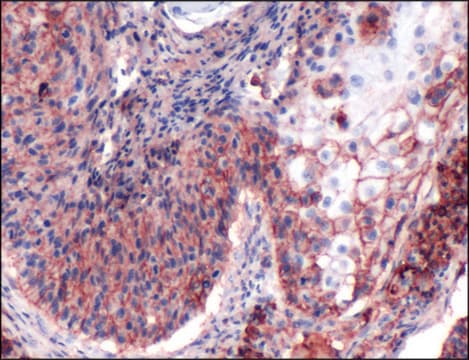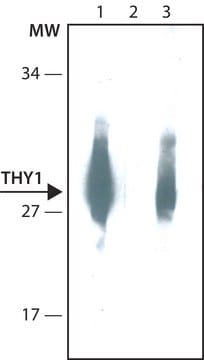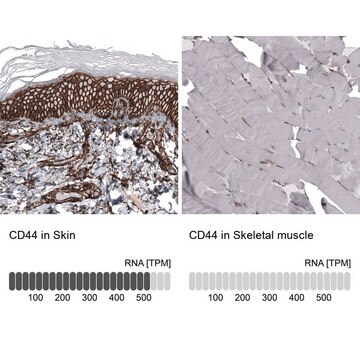一般說明
We are committed to bringing you greener alternative products, which adhere to one or more of The 12 Principles of Green Chemistry.This antibody is Preservative-free, produced without the harm or sacrifice of animals and exceptionally stable to allow for ambient shipping and storage if needed and thus aligns with "Waste Prevention", "Designing Safer Chemicals" and "Design for Energy Efficiency".
Click here for more information.
ZooMAb® antibodies represent an entirely new generation of recombinant monoclonal antibodies. Each ZooMAb® antibody is manufactured using our proprietary recombinant expression system, purified to homogeneity, and precisely dispensed to produce robust and highly reproducible lot-to-lot consistency. Only top-performing clones are released for use by researchers. Each antibody is validated for high specificity and affinity across multiple applications, including its most commonly used application. ZooMAb® antibodies are reliably available and ready to ship when you need them.
特異性
Clone 5H23 is a ZooMAb® rabbit recombinant monoclonal antibody that specifically detects CD44. It targets an epitope within 16 amino acids from the extracellular domain within the C-terminal half.
免疫原
KLH-conjugated linear peptide corresponding to 16 amino acids from the C-terminal half, extracellular domain of human CD44.
應用
Quality Control Testing
Evaluated by Western Blotting with recombinant Human CD44.
Western Blotting Analysis (WB): A 1:10,000 dilution of this antibody detected recombinant Human CD44.
Tested Applications
Enzyme Immunoassay Analysis: A Series of Dilutions from a representative lot detected CD44 in CD44 and GST proteins.
Flow Cytometry Analysis: 1 μg from a representative lot detected CD44 in one million Human peripheral blood mononuclear cells (PBMC).
Immunohistochemistry (Paraffin) Analysis: A 1:1,000 dilution from a representative lot detected CD44 in human skin tissue sections.
Affinity Binding Assay: A representative lot of this antibody bound recombinant Human CD44 protein with a KD of 2.2 x 10-6 in an affinity binding assay.
Immunofluorescence Analysis: A 1:1,000 dilution from a representative lot detected CD44 in Human skin tissue sections.
Note: Actual optimal working dilutions must be determined by end user as specimens, and experimental conditions may vary with the end user.
標靶描述
CD44 antigen (UniProt: P16070; also known as CDw44, Epican, Extracellular matrix receptor III, ECMR-III, GP90 lymphocyte homing/adhesion receptor, HUTCH-I, Heparan sulfate proteoglycan, Hermes antigen, Hyaluronate receptor, Phagocytic glycoprotein 1, PGP-1, CD44) is encoded by the CD44 (also known as LHR, MDU2, MDU3, MIC4) gene (Gene ID: 960) in human. CD44 is a single-pass type I, highly glycosylated membrane protein that is synthesized with a signal peptide (aa 1-20), which is subsequently cleaved off to generate the mature form that contains an extracellular domain (aa 21-649), a transmembrane domain (aa 650-670), and a cytoplasmic domain (aa 671-742). Nineteen different isoforms of CD44 have been described that are produced by alternative splicing. All isoforms possess a hyaluronic acid (HA)-binding domain in its N-terminal region of the extracellular domain. CD44 expression is observed on all leukocytes, endothelial cells, hepatocytes, and mesenchymal cells. It binds to several ligands including hyaluronic acid (HA), Osteopontin, chondroitin, collagen, fibronectin, and serglycin/sulfated proteoglycan. However, the main ligand for CD44 is HA that is expressed by stromal and cancer cells. HA binds the CD44 ligand binding domain and induces conformational changes that allow binding of adaptor proteins or cytoskeletal elements to intracellular domains. This leads to the activation of various signaling pathways leading to cell proliferation, adhesion, migration, and invasion. Overexpression of CD44 has been reported in several cell types and it is considered as an ideal marker for cancer stem cells. Its interaction with appropriate extracellular matrix ligands promotes the migration and invasion processes involved in tumor metastases. This ZooMAb® recombinant monoclonal antibody, generated by our propriety technology, offers significantly enhanced specificity, affinity, reproducibility, and stability over conventional monoclonals. (Ref.: Chen, C., et al. (2018). J. Hematol. Oncol. 11; Article 64). Senbanio, LT., and Chellaiah, MA (2017). Front. Cell Dev. Biol. 5; 18).
外觀
Purified recombinant rabbit monoclonal antibody IgG, lyophilized in PBS, 5% Trehalose, normal appearance a coarse or translucent resin. The PBS/trehalose components in the ZooMAb formulation can have the appearance of a semi-solid (bead like gel) after lyophilization. This is a normal phenomenon. Please follow the recommended reconstitution procedure in the data sheet to dissolve the semi-solid, bead-like, gel-appearing material. The resulting antibody solution is completely stable and functional as proven by full functional testing. Contains no biocide or preservatives, such as azide, or any animal by-products. Larger pack sizes provided as multiples of 25 μL.
重構
300 μg/mL after reconstitution at 25 μL per vial. Please refer to guidance on suggested starting dilutions and/or titers per application and sample type.
儲存和穩定性
Recommend storage of lyophilized product at 2-8°C; Before reconstitution, micro-centrifuge vials briefly to spin down material to bottom of the vial; Reconstitute each vial by adding 25 μL of filtered lab grade water or PBS; Reconstituted antibodies can be stored at 2-8°C, or -20°C for long term storage. Avoid repeated freeze-thaws.
法律資訊
ZooMAb is a registered trademark of Merck KGaA, Darmstadt, Germany
免責聲明
Unless otherwise stated in our catalog or other company documentation accompanying the product(s), our products are intended for research use only and are not to be used for any other purpose, which includes but is not limited to, unauthorized commercial uses, in vitro diagnostic uses, ex vivo or in vivo therapeutic uses or any type of consumption or application to humans or animals.








